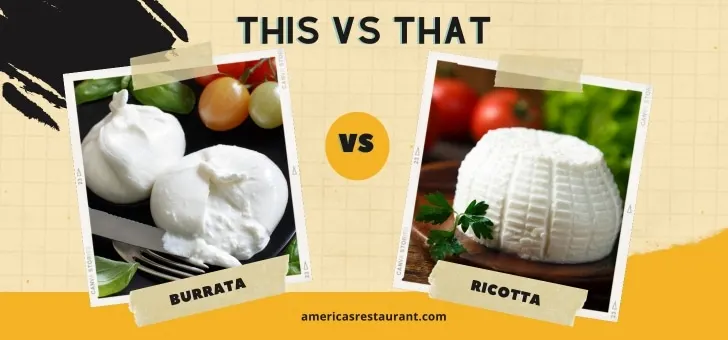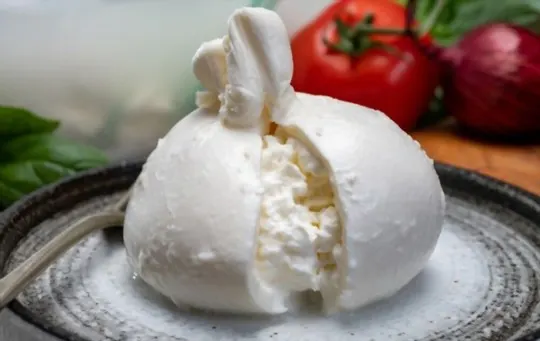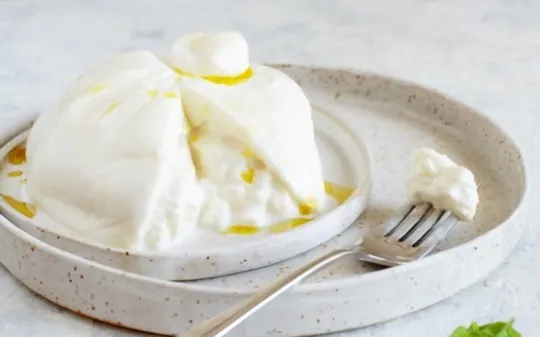In the great cheese showdown, we’ve got two contenders. Burrata and Ricotta.
Two cheeses walk into a kitchen. Sounds like the start of a joke, right? Well, we’re here to talk serious business. The creamy goodness of Burrata battles the light, fluffy texture of Ricotta.
Our personal battle with choosing between them at the grocery store is real. One day, Burrata rules our hearts with its rich, buttery center. The next, Ricotta wins us over with its versatility.
Which will claim victory in your kitchen?

What is Burrata?

Burrata, an Italian cheese, comes from Apulia in Southern Italy.
It is known for its soft, buttery texture and mild flavor.
This cheese is a delicacy that owes its popularity to the filling inside it.
It is made with a combination of fresh mozzarella curds and cream.
Moving ahead, burrata has a unique texture as compared to other cheeses due to its preparation method.
The cheese’s outer shell is made of mozzarella cheese while the smooth and creamy interior part contains some fresh cream with stracciatella filling.
Due to its short shelf life, burrata needs to be consumed fresh.
It’s important to note that burrata requires experienced hands while making because it’s delicate and tends to fall apart easily.
Hence, it’s always recommended to buy from trusted stores or vendors who specialize in the production of authentic burrata.
Overall, Burrata is ideal for gourmet platters like charcuterie boards because it adds sophistication and visual appeal while being delicious.
Now that we’ve understood what Burrata is let’s explore how it differs from ricotta–another popular Italian cheese alternative.
What is Ricotta?

Ricotta is a fresh cheese that has a mild and slightly sweet taste.
It is made from whey, a byproduct of cheese-making, which is heated to separate the leftover curds.
The resulting soft, grainy texture of ricotta makes it ideal for use in cooking and baking.
Its versatility allows it to be used as a filling for dishes like lasagne, canoli or even spread on toast.
Due to its low fat content and high protein levels, it has become a popular choice amongst health-conscious individuals seeking an alternative to regular cheese.
Differences Between Burrata and Ricotta

Burrata and ricotta are both soft, creamy Italian cheeses that may seem similar at first.
However, they differ in several ways that make them distinct from one another.
- Burrata is a fresh cheese made from mozzarella and cream, whereas ricotta is made from the whey left over after making other cheeses.
- The texture of burrata is delicate and stringy, with a rich creamy filling in the center, while ricotta is grainy and slightly sweet in flavor.
Overall, both are delicious options for different recipes, but the choice depends on personal preference.
1 – Ingredients and Production
This section delves into the distinctions between burrata and ricotta in terms of ingredients and production.
Burrata, a fresh Italian cheese, is created by wrapping a combination of mozzarella and cream around a stracciatella filling.
In contrast, ricotta is produced through re-cooking the whey remaining after cheese-making with vinegar or citric acid.
While both cheeses share similarities in their texture, they diverge greatly when it comes to flavor and composition.
2 – Texture and Consistency
The texture and consistency of cheese are essential considerations when deciding on what to include in your recipe or pair with wines.
Burrata, with its buttery exterior shell and creamy fillings, has a smooth, melty, and soft texture that oozes out when cut open.
On the other hand, ricotta is grainy and crumbly with a slightly sweet taste.
Both types have a fresh flavor that complements various dishes.
In addition to their unique textures, burrata tends to be more cohesive than its counterpart ricotta.
This is because they are made differently; burrata is an amalgamation of mozzarella cheese filled with cream or stracciatella cheese while curds create ricotta.
Therefore, burrata’s filling creates that gooey coherence that ricotta lacks.
The cohesion of burrata not only adds a dynamic layer with every bite but also makes it easier to incorporate into recipes.
3 – Flavor Profile
The flavor profile of burrata and ricotta is distinctive and significant.
Burrata has a creamy and rich flavor with a tinge of acidity, while ricotta has a subtle sweetness with a mild nutty taste.
Burrata’s decadent creaminess is an excellent addition to salads, pizzas, and pastas, whereas ricotta’s lightness adds depth to cannoli, lasagna, and cakes.
Both cheeses have versatile uses but offer different taste experiences.
4 – Culinary Uses
Burrata and ricotta are versatile ingredients that can add depth and richness to many dishes.
They have different textures and flavors, making them great for unique culinary uses that can elevate a dish’s taste.
The creamy and mild flavor of burrata makes it perfect for using in salads, pasta, and pizza toppings.
On the other hand, the slightly grainy texture of ricotta is suitable for desserts such as cheesecake or cannoli fillings, lasagne, stuffed shells, or even as a dip with vegetables.
Incorporating these two cheeses into different cuisines opens up endless possibilities for creating new recipes that people will love.
Similarities Between Burrata and Ricotta

Both Burrata and Ricotta are soft Italian cheese varieties that have similarities.
They are both made using milk, with Burrata being made from mozzarella and cream while Ricotta is made from whey.
Both cheeses have a creamy texture that makes them versatile for use in many dishes.
Burrata and Ricotta can be used as a spread on crackers or bread; they can also be incorporated into pasta dishes and salads to add flavor.
Moreover, both cheeses belong to the fresh cheese family which signifies their short shelf life.
The best way to keep them fresh longer is by storing them in their original packaging containers or wrapping them in parchment paper before refrigerating.
While they share similarities, Burrata has an outer shell made of mozzarella and cream while Ricotta is less creamy with no outer shell.
Overall, while there may be some similarities between the two cheeses, they serve different purposes when it comes to culinary arts.
Burrata’s creamy texture makes it a perfect choice for adding depth to a dish, whereas Ricotta’s mild taste works well as an ingredient in baked goods like lasagna or cannolis.
Ultimately, it all comes down to personal preferences when deciding which one is better suited for your dish.
Availability and Accessibility
The comparison between Burrata and Ricotta cheese also takes into account the availability and accessibility of these two types of cheeses.
While both are widely available in grocery stores, the distribution may vary depending on the region.
Burrata being a more premium cheese may be relatively harder to find than Ricotta.
However, with the rise in popularity of Italian cuisine, both cheeses are easily accessible at most local stores and markets.
The ease of buying these cheeses makes them an excellent option for cooking enthusiasts who want to try out new recipes using traditional ingredients.
When it comes to availability, Burrata can be easier to find in specialty cheese shops or artisanal food markets.
These shops usually stock high-quality items sourced from small-scale producers that may offer unique flavors and textures unavailable in chain-stores or supermarkets.
On the other hand, Ricotta is available in most major grocery stores as it is widely produced and commercially sold worldwide.
However, in terms of accessibility, both cheeses are equally convenient to purchase.
Online shopping platforms like Amazon Fresh and Instacart have made it possible for customers to buy these products without leaving their homes.
Supposing that factors like location and delivery charges don’t apply; accessibility should not be a deciding factor when choosing between Burrata vs Ricotta Cheese.
Regardless of which you prefer better between Burrata or Ricotta Cheese, both varieties are available online or locally catering to everyone’s needs and requirements.
Conclusion
The analysis concludes with a better understanding of the qualities and differences between Burrata and Ricotta.
Both cheeses have their strengths, with Burrata having a smoother texture and richer flavor while Ricotta is lighter, simpler, and more versatile.
In terms of nutrition, Burrata has more calories and fat content than Ricotta; however, both contain protein and offer health benefits to some degree.
Ultimately, choosing between Burrata and Ricotta comes down to personal taste preference and intended use in recipes.

Leave a comment